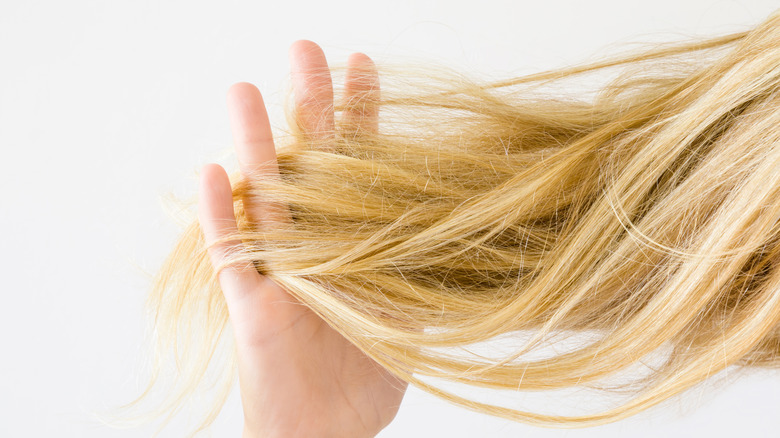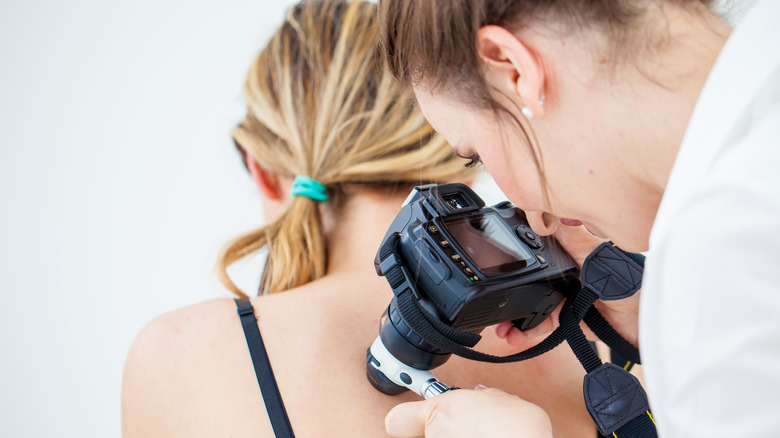The Unfortunate Health Drawbacks Of Being Blond
People with blond hair have a long history of existing between the realm of being approached first at a party and being considered unintelligent. For men, having blond hair is sometimes grouped with being evil. If you have friends with blond hair or you have blond hair yourself, you know that there is no truth to these claims, especially the ones about intelligence and morality. They are unfortunate tropes that have been passed down by works of fiction — TV shows, movies, and books.
Your hair color isn't a clue to your level of intelligence or vileness. In fact, according to an evolutionary geneticist at Stanford University in California, David Kingsley (via Science ABC), whether you end up with blond locks is determined by a mutation in your DNA, more specifically, a signaling gene that has a kind of ripple effect on other genes involved in melanin production. Basically, those with blond hair have the mutation which results in less melanin production, and therefore, a lighter shade of hair. What's more, people with blond tresses also contain very little eumelanin, a type of melanin associated with black or brown hair. They, instead, contain higher levels of pheomelanin, another type of melanin linked with yellow to red pigment.
If you were to ask someone with blond hair, they'd probably have a list of regular hair struggles associated with their hair color — like needing to be extra cautious at the pool because of chlorine and its fading effects and eyebrow makeup woes. Did you know that there are hair health drawbacks like losing your hair or having to deal with brittle locks too?
Blond tresses create unique hair health challenges
According to Unilever senior scientist Diane Minar, your hair color has a connection to how many strands you have on your head at any given time (via SELF). Although those with blond hair have a higher concentration of hair — 450,000 strands on average — when compared with their darker-haired counterparts with an average of 60,000 strands, they also shed a lot more. Higher density of hair means finer strands too.
"On average, seven percent of the scalp hair is shedding, so per day, naturally blonde women can experience higher numbers of natural shedding from the root when compared to other hair types," explained Minar.
Additionally, blond hair is also more susceptible to sun damage (owing to its low melanin content). Being in the sun for long periods of time can lead to dry and brittle locks that develop split ends in general, but the concern is particularly pronounced with tresses of a lighter shade. Unfortunately, the health concerns don't stop with what's on your head. Apparently, blond hair can also tell you something about your eye health.
Blond hair is linked with age-related macular degeneration
Age-related macular degeneration, or AMD as it's known in short, affects your central vision. Blurry or fuzzy vision, having a hard time recognizing faces, seeing straight lines as wavy, having blind spots in the center of your vision, and being unable to drive, read, or do any work close-up owing to loss of central vision are some of the symptoms of this eye disease.
According to a 2014 study published in the journal Investigative Ophthalmology & Visual Science, those with blond or red locks who also spent more than two hours outside daily during the hot summer months in their teen years (classified as medium or high sun exposure), were more at risk of developing AMD when compared with those who spent less time in the sun during summer. However, those with darker-hued tresses were not found to be at risk in the same way that those with blond or red hair were. An older study published in the journal Ophthalmology had similar findings.
Tied to this, are the surprising things your eye color can tell you about your health. People with fairer skin and blue eyes and those with a family history of the eye disease are also considered to be more at risk of developing AMD. The disease commonly affects those over 50 years of age and other contributory factors include high blood pressure, a diet high in saturated fat, and smoking.
Blond hair is also associated with greater melanoma risk
According to a 2024 Mendelian randomization study published in the journal Gene, which analyzed data from a meta-analysis from the UK Biobank Consortium that included 360,270 individuals with origins in Europe, cutaneous melanoma, or CM, was found to be more of a risk in subjects with red, blond, and light brown hair. While the individuals with black hair showed no risk, those with dark brown hair showed less of a risk than the group containing blond-haired subjects. Similar results were reported in an older study published in the International Journal of Cancer.
Melanoma refers to cancer that originates in the cells that produce melanin — melanocytes. Cutaneous melanoma, or melanoma of the skin, is potentially life-threatening and is the most common form of melanoma and the fifth most common type of cancer in the U.S. Having a history of sunburn; being exposed to UV light from the sun or tanning beds; having a lot of moles or unusual-looking moles; having sun-sensitive light skin, light hair, and light-hued eyes; and having a weakened immune system are all considered risk factors. Family history of the disease and being over 50 years of age are thought to be contributing factors too.
How your hair color ties in with eye and skin health
When thinking of caring for your tresses, it is easy to get lost in tips to maintain healthy hair with shampoo or go in search of serums, masks, and oils that prevent hair loss. But hair care is a lot more than what you apply to your locks. It involves nutrition, sleep, stress relief, and protection from the sun, to name a few other important players.
For starters, it might be time to consider your hair in addition to your skin when you step out in the sun. Wear a wide-brimmed hat, cover your strands with a scarf, or avoid staying out for long periods of time in the sun fully exposed. Just like SPF protection for your skin, your hair needs shielding from the sun's damaging rays too. After all, sun sensitivity owing to less melanin is the root cause of some of the main health concerns pertaining to lighter-hued tresses. Limiting the use of heating tools; moisturizing well with avocado, shea butter, or honey-based haircare products; and oiling your hair (particularly if it's damaged) can help too.
As for your eye and skin health, it's important to be on the lookout for symptoms. While we've already discussed the concerns related to age-related macular degeneration, with melanoma, you should watch for suspicious or unusual mole-related signs, like changes in existing moles when it comes to color, texture, size, and appearance, and itchy or bleeding moles. There is also such a thing as hidden melanomas which can develop in your mucous membranes, in your eyes, or under a nail.





